In a comment to my recent post about Mac Smith and his wild round at Gopher Lakes (Hazeltine), ishmael66 raised a question as to how the GC would handle putting off the green into the water as can happen on Hole #10. In this post, I propose three ways of dealing with this problem.
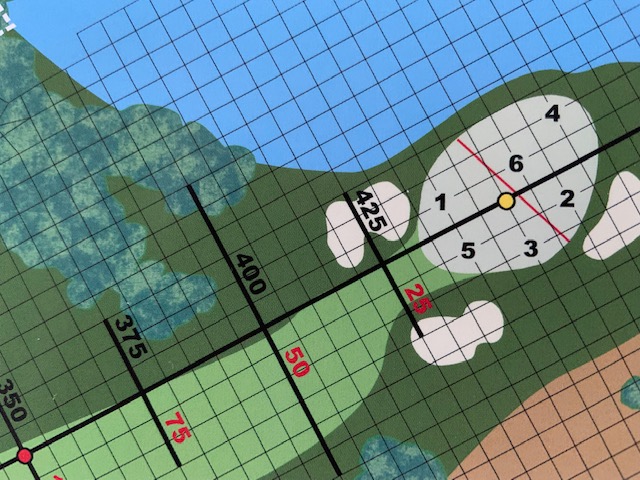
The hole notes state, “For shots coming to rest in the rough left of the green, roll one die. On 1 or 2, the ball rolls into the water. . . For all missed putts to pin 4, roll one die and add to the remaining distance. If this total is 10 feet or more, the ball has rolled off the green. Place ball at nearest cross off the green then check if ball rolled into water as if the ball had come to rest left of the green.”
In our example, let’s assume that all players are on the green. Let’s also assume Shane Lowry’s first putt goes off the green into the water (based on a lie roll of 1 or 2). We’ll record the missed putt distance in cell P1 in the Putting Board Notes.
In this instance, the initial putt was from 41 feet to pin 4 and that resulted in a missed putt of 10 feet (after applying the single die roll to the remaining distance from the Putting Board). We enter 10 into the P1 box for Lowry, and the stroke count automatically updates to 3 as shown below.
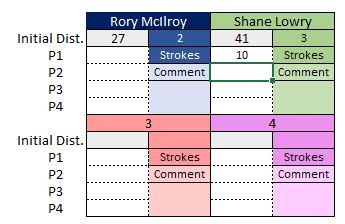
The easiest (but riskiest) way to proceed is to take a penalty stroke and re-putt from the same distance (41 feet). To do this, we click on the player’s Caddie tab and use the Place Ball at Location tool to put the ball in the water. We’ll arbitrarily choose 465 L20 as the coordinates.
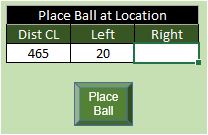
After clicking the Place Ball button, we are prompted to record a lie. We select the radio button next to the empty white box and enter WATER then click Record.
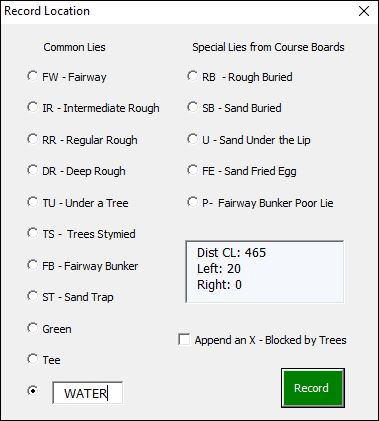
That records our penalty stroke in the Notes on the Caddie tab. If we were scoring manually, we might enter Penalty in the Comments box as a reminder–but that isn’t required.

We can now go back to the Putting Boards and (after a short prayer) re-hit from 41 feet. We just have to remember to putt from 41 feet (not 10) in this case. Let’s assume both golfers putt out without further misadventure (i.e., our prayer was answered).
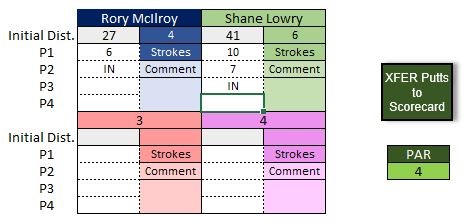
Notice that in the image above the number of strokes for Lowery is 6, which is correct. Although not shown on the Putting Boards, here are the six strokes:
- Tee shot
- Shot onto green
- 41-foot putt into water
- Penalty stroke
- 41-foot putt (missed)
- 7-foot putt (made)
We can now click on the XFER Putts to Scorecard button to go to the Scorecard tab. We’ve elected to use the Autofill automated scoring feature. Here’s Lowry’s scorecard through Hole #10:
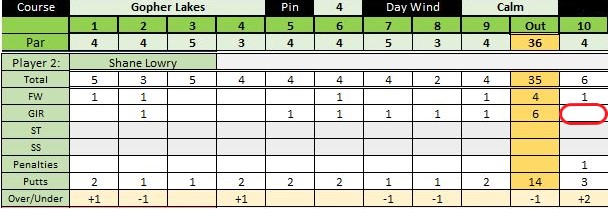
Everything has recorded correctly with the possible exception of the Green in Regulation (GIR). That’s because this is a par 4 and we have more than two lies entered in the Notes on the Caddie tab (FW, GREEN, and WATER). Remember, we added the WATER lie to be able to capture the penalty stroke. I’m not 100% sure of the scoring rule in a situation where the ball is on the green in regulation then leaves and returns to it, but we could easily enter a 1 in the Hole #10 GIR box for Lowry if we wanted to record a GIR.
If we had holed out on our second 41-foot putt attempt, we would also need to edit the Notes on the Scorecard tab. That’s because the GC uses the number immediately above IN to calculate Total Length Putts Made and to determine Longest Putt Made. This will be illustrated in our next example.
The second way to handle putting off the green is to drop the ball one square from where it went into the water. We’ll use the same golfers and setup. Let’s pick it up where Lowry has just missed his initial putt (of 41 feet) by 10 feet and ended up in the water (following a lie roll of 1 or 2).
Since we are going to relocate the ball to a spot off the green and we have already recorded his missed 41-foot putt on the Putting Boards, we don’t want to duplicate that information here. That would cause us to have an extra stroke. (Ignore the Stroke count for the Notes on the Caddie tab at this point; it’s the Stroke count on the Putting Boards that matters.)

Instead, we’ll drop the ball next to the water in the rough. Since the ball supposedly entered the water “at the nearest cross off the green,” we’ll drop it at 465 L15 using the Place Ball at Location tool.
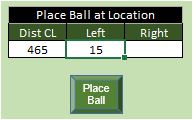
When prompted for a lie, we select RR – Regular Rough and click Record.
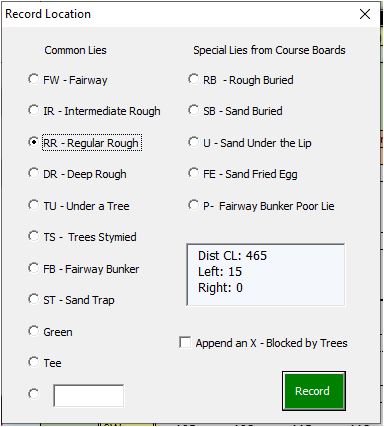
Now, the Notes for Lowry look like this.

After dropping the ball, I would ignore the hole note’s instruction to roll for the lie when the ball is in the rough left of the green. It’s inconceivable to me that a pro would drop the ball in such a way that it rolls into the water.
At this point, we need to get Lowry back on the green using an Approach shot. Based on where we dropped (i.e., placed) the ball, he is 5 yards from the pin. So, we’ll use the 5 – 10 Yard Approach Board.
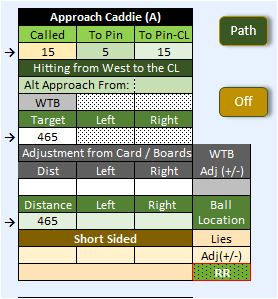
We bring up the All in One Menu and take the shot as normal.
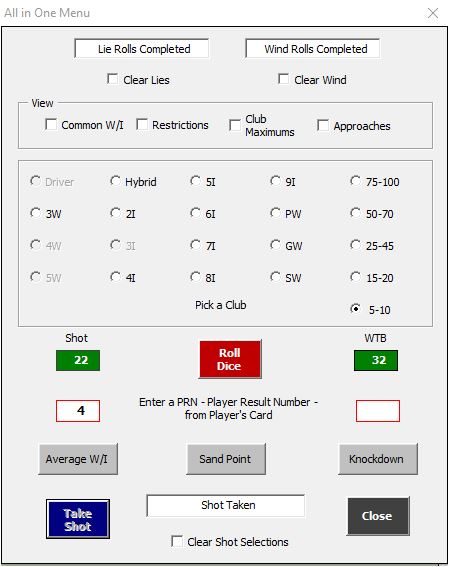
Notice that the Putt Dist. in the Notes has changed from its original value (41) to its new value (7 in this case). Remember that number!

Using the Update Arrow, select the Green lie option then click Record. (If you use the Ball on Green tool in this situation, you will get a warning telling you that your ball is already on the green.) That clears out the Putt Dist. number in the Notes, so we’ll need to go back and re-enter our new Putt Dist. value (7).will get a warning telling you that your ball is already on the green.

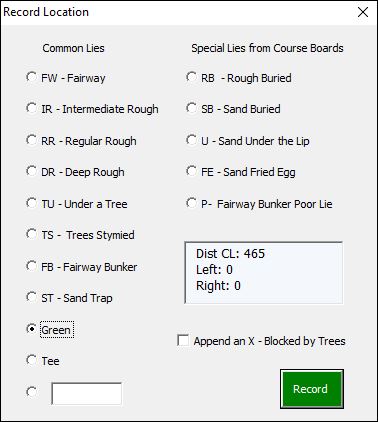

We can now return to the Putting Boards and proceed as normal.
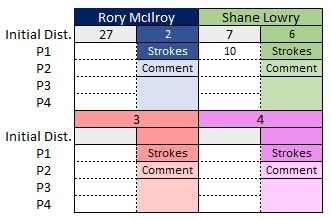
In the above image, notice that the new putt distance (7 ft.) is recorded in the Initial Dist. box for Lowry. We need to be sure to use the column for 7 – 9 feet (not 10 – 14 feet) when we take his next putt.
We’ll putt out in the normal fashion and assume we get the results shown below.
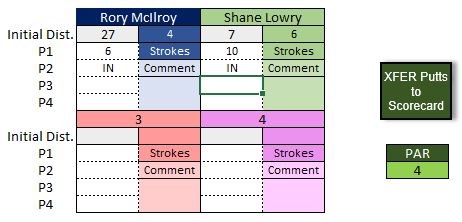
As you can see in the image above, our stroke count for Lowry is now correct:
- Tee shot
- Shot onto green
- 41-foot putt into water
- Penalty stroke
- 5-yard approach shot
- 7-foot putt (made)
Since we are keeping stats, we have a little bit of cleaning up to do after clicking the XFER Putts to Scorecard button.
We’re using the GC’s automated scoring feature, but you’ll notice in the image below that, as before, Lowry didn’t get credit for a Green in Regulation (GIR), even though he was on in two on this par 4. Nor did he get dinged with a penalty stroke. Again, we can manually enter a 1 into either of these boxes to reconcile the scorekeeping.
Although the stroke for the penalty was counted in his Total for the hole, it wasn’t recorded as a penalty stroke since we used the RR lie when we dropped his ball beside the water. The Lie column in the Notes MUST have an entry that starts with: UN (unplayable), W (water), OB (out-of-bounds), LB (lost ball), or PE (penalty) in it for the Autofill feature to record it as a penalty stroke. If we had recorded the shot in the Notes as having gone in the water, we couldn’t drop the ball anywhere off the green as it would have resulted in an extra stroke. (We didn’t have this problem in the first example, because we re-hit from the green.)
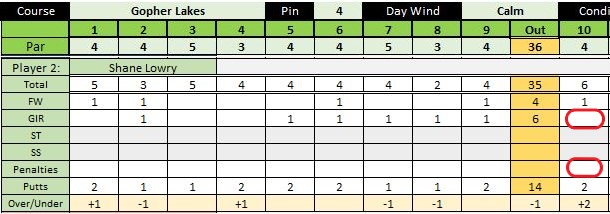
To make sure his Made Putting Distance is accurate, we need to manually edit Lowry’s Scorecard Notes for Hole #10. As it stands now, he’s getting credit for a 10-foot putt instead of the 7-footer he sunk. That’s because the GC uses the value immediately above IN.
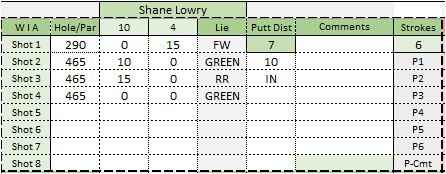
That’s easy enough to remedy. All we have to do in this case is reverse the numbers by typing over them.
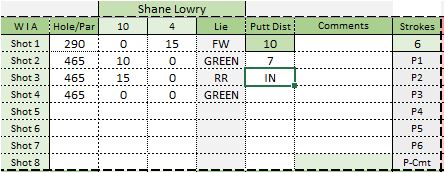
After re-ordering the putt distances in the Scorecard Notes, the Total Length Putts Made and Longest Putt Made calculations will be accurate.
There is at least one more solution to this problem that you may have figured out by now. Once the putt goes off the green, you could revert to playing without the Game Caddie until you finished the hole. Then edit the Scorecard and the Scorecard Notes as just shown to make sure all your scores and stats are correct.
The GC is reasonably flexible and can handle most situations, if in no other way, by use of the Place Ball at Location tool or by simply editing the Scorecard. Should putting off the green or other odd scenarios start appearing on multiple courses, I will modify the GC to accommodate them in a more user-friendly fashion. Until then, it isn’t possible to guess at all the unique situations that may arise for courses I’ve never seen and ones that may come out in the future.
Thanks for the question, ishmail66. I hope you and others enjoyed this interesting exercise and that you (and I) NEVER have to use it!